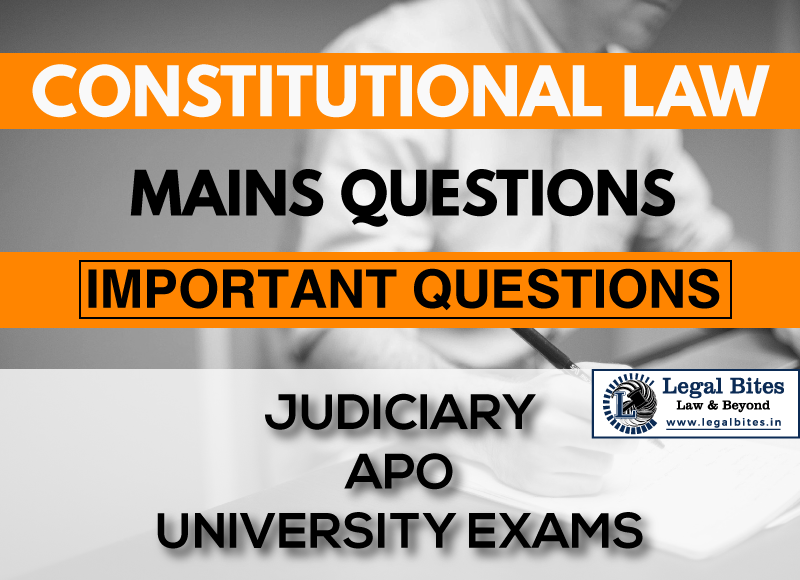Discuss the scope of the protection given to life and liberty under the Indian Constitution. Refer to the latest Supreme Court decision.
Question: Discuss the scope of the protection given to life and liberty under the Indian Constitution. Refer to the Supreme Court decisions. [BJS 1980] Find the answer to the mains question only on Legal Bites. [Discuss the scope of the protection given to life and liberty under the Indian Constitution. Refer to the latest Supreme Court decision.] Answer… Read More »

Question: Discuss the scope of the protection given to life and liberty under the Indian Constitution. Refer to the Supreme Court decisions. [BJS 1980] Find the answer to the mains question only on Legal Bites. [Discuss the scope of the protection given to life and liberty under the Indian Constitution. Refer to the latest Supreme Court decision.] Answer The Government of India Act, 1935 established Article 21 in the Constitution of India which states that no person shall be deprived of...
Question: Discuss the scope of the protection given to life and liberty under the Indian Constitution. Refer to the Supreme Court decisions. [BJS 1980]
Find the answer to the mains question only on Legal Bites. [Discuss the scope of the protection given to life and liberty under the Indian Constitution. Refer to the latest Supreme Court decision.]
Answer
The Government of India Act, 1935 established Article 21 in the Constitution of India which states that no person shall be deprived of his life and liberty except according to the procedure established by law. The right to life and personal liberty enshrined in the provision is one of the fundamental rights guaranteed to all citizens and non-citizens of India under Part III of the Constitution. Article 21 is described as the heart of fundamental rights.
While the provision states for two rights, i.e. right to life and right to personal liberty, the meaning and scope of Article 21 have been widened by the Judiciary in many cases over the years.
One of the first case laws on this provision was A.K Gopalan v. State of Madras [AIR 1950 SC 27] in which the Supreme Court took a narrow interpretation of Article 21 and held that this fundamental right is only available against arbitrary executive action and not against arbitrary legislative action. Meaning, the case empowered the state to deprive a person of his fundamental rights in Article 21 based on a law.
This judgment was flawed in many ways, so in 1978 the Supreme Court overruled its judgment of the Gopalan Case and took a wider interpretation of Article 21 in the landmark judgment of Maneka Gandhi v. Union of India [1978 AIR 597]. The SC in this case held that the right to life and liberty of a person can be deprived by law on the condition that the procedure established by that law is reasonable, fair, and just.
It must satisfy the principle of natural justice, which is a basic component of fair procedure under Article 21. It further ruled that the right to life doesn’t merely mean animal existence and it covers all those aspects of a life which contribute to making a man’s life meaningful, complete, and worth living.
After Maneka Gandhi’s case ruling, there were more historic judgments that widened the scope of Article 21. Some of them are as follows:
- In Sunil Batra v. Delhi Administration [(1978) 4 SCC 409], the Supreme Court ruled the use of fatal handcuffs for the convicted persons as unconstitutional as it suggests inhuman behaviour towards the prisoner.
- In Mohini Jain v. State of Karnataka [1992 AIR 1858], the court ruled that the right to life also includes the right to education.
- In Shubhash Kumar v. State of Bihar [AIR 1991 SC 420], the court ruled the right to life also includes within itself the right to get pollution-free air.
In another landmark judgment of Unni Krishnan v. State of Andhra Pradesh [1993 AIR 2178], the court held that the right to education is a fundamental right to the children for the age of 6 to 14 years.
Important Mains Questions Series for Judiciary, APO & University Exams
- Constitutional Law Mains Questions Series Part-I
- Constitutional Law Mains Questions Series Part-I
- Constitutional Law Mains Questions Series Part-II
- Constitutional Law Mains Questions Series Part-IV
- Constitutional Law Mains Questions Series Part-V
- Constitutional Law Mains Questions Series Part-VI
- Constitutional Law Mains Questions Series Part-VII
- Constitutional Law Mains Questions Series Part-VIII
- Constitutional Law Mains Questions Series Part-IX
- Constitutional Law Mains Questions Series Part-X
Admin Legal Bites
Legal Bites Study Materials correspond to what is taught in law schools and what is tested in competitive exams. It pledges to offer a competitive advantage, prepare for tests, and save a lot of money.
